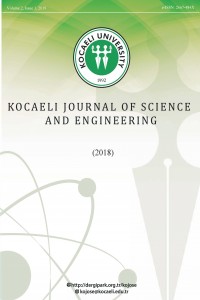Abstract
References
- Goh T.N, 2002. A Strategic Assessment Of Six Sigma. Quality And Reliability Engineering International, 18, pp. 403-410.
- Çeliknalça F.F, 2006. Evaluating Quality in Mass- Housing Projects Via Six Sigma: The Case of ODTÜKENT, Master's Thesis, Middle East Technical University, The Graduate School of Natural and Applied Sciences, Ankara.
- Dağlıoğlu G., İnal T., Aksoy K., 2009. What is Six Sigma? Archive Source Browsing Journal, 18(2), p.132.
- Gürsakal N., 2008. Descriptive Statistics, 4th ed., Dora Publishing, Bursa.
- Eckes G., 2007. Six Sigma For Everyone (Translater: Adıyaman B.), MediaCat Publications, Istanbul, pp.10-11.
- Baş T., 2003. Six Sigma, 5th ed., Quality Office Publications, İstanbul.
- Işığıçok E., 2005. Hypothesis Testing for Six Sigma Black Belts Roadmap, Sigma Center Management Systems, Bursa.
- Özgen G., 2006. Six Sigma Methodology and an Application in the Electricity Sector, M.Sc. Thesis, Institute of Natural and Applied Sciences, Gazi University, Ankara.
- Dmaic, 2010. Brief Description of DMAIC Applications, p.15, https://www.isixsigma.com /new-to-six-sigma/dmaic/six-sigma-dmaic-roadmap. (Access Date: 23.12.2018).
Abstract
In
today's world of increasing international trade, companies are suggested to
learn, implement and maintain new production techniques in place of traditional
production systems in order to sustain their assets. In this approach, we have
worked on “Six Sigma”, one of the strongest components of these so-called
systems. Within the scope of this study, Six Sigma and its application areas
are investigated, and as a result of the obtained findings, six sigma
applications have been made in the textile industry where the quality is
desired to be improved. In the study, conducted by following the six sigma's
DMAIC (Define, Measure, Analyse, Improve, Control) steps, using the detection
tools such as SIPOC (Suppliers, Inputs, Process, Outputs, Customers) diagrams,
measurement systems analysis, root cause analysis, determination of poor
quality sources and improvement on the basic problem have been made. The
variation of the strips from the card and cer machines in the plant created
great quality problems. Before the six sigma project, the average coefficient
of variation value of the card machines was 2.02. With this project, the
average coefficient of variation value
of the card machines is aimed to be reduced to 0.5-1.5 range. After the six
sigma project, the average voefficient of variation value of the card machines
was reduced to 1.03.
References
- Goh T.N, 2002. A Strategic Assessment Of Six Sigma. Quality And Reliability Engineering International, 18, pp. 403-410.
- Çeliknalça F.F, 2006. Evaluating Quality in Mass- Housing Projects Via Six Sigma: The Case of ODTÜKENT, Master's Thesis, Middle East Technical University, The Graduate School of Natural and Applied Sciences, Ankara.
- Dağlıoğlu G., İnal T., Aksoy K., 2009. What is Six Sigma? Archive Source Browsing Journal, 18(2), p.132.
- Gürsakal N., 2008. Descriptive Statistics, 4th ed., Dora Publishing, Bursa.
- Eckes G., 2007. Six Sigma For Everyone (Translater: Adıyaman B.), MediaCat Publications, Istanbul, pp.10-11.
- Baş T., 2003. Six Sigma, 5th ed., Quality Office Publications, İstanbul.
- Işığıçok E., 2005. Hypothesis Testing for Six Sigma Black Belts Roadmap, Sigma Center Management Systems, Bursa.
- Özgen G., 2006. Six Sigma Methodology and an Application in the Electricity Sector, M.Sc. Thesis, Institute of Natural and Applied Sciences, Gazi University, Ankara.
- Dmaic, 2010. Brief Description of DMAIC Applications, p.15, https://www.isixsigma.com /new-to-six-sigma/dmaic/six-sigma-dmaic-roadmap. (Access Date: 23.12.2018).
Details
| Primary Language | English |
|---|---|
| Subjects | Engineering |
| Journal Section | Articles |
| Authors | |
| Publication Date | May 31, 2019 |
| Acceptance Date | December 19, 2018 |
| Published in Issue | Year 2019 Volume: 2 Issue: 1 |


